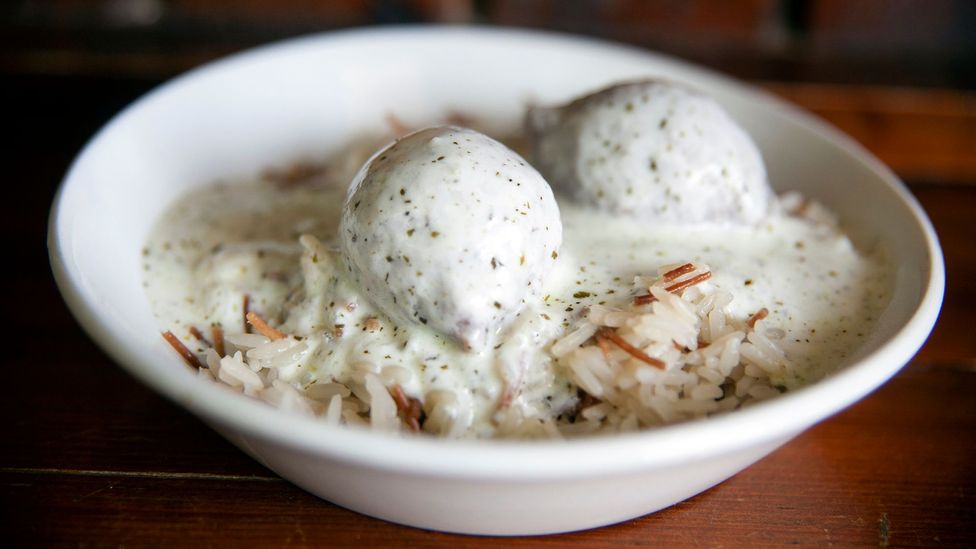
Kibbeh labaniyeh: Lebanese meatballs to start a new year
- Published By The Statesman For The Statesman Digital
- 1 year ago
Barbara Massaad's cookbook, Forever Beirut, shares a recipe for meatballs in yoghurt sauce that is served in Lebanon on New Year's Day.
To start the year with a clean slate in Lebanon, the hearty dish of kibbeh labaniyeh (meatballs in a thick mint yoghurt sauce) is served at family tables on New Year's Day. For award-winning cookbook author, food consultant and president of Slow Food Beirut, Barbara Massaad, kibbeh labaniyeh is "comfort food with a capital C".
"My kids always make fun of me because I say it 10 times when we're eating it," Massaad said from her home in Beirut, as she cracked eggs into a pan of heated yoghurt. "Kibbeh labaniyeh is white, pure… it's so good. Everything that has to do with dairy is nurturing and delicious."
Her recipe for kibbeh labaniyeh appears in her 2022 cookbook Forever Beirut, which compiles all the important tabkheh (everyday recipes from family homes) in Lebanon.
"We take the tabkheh very seriously," Massaad explained. "One of the priorities for women in Lebanon is to have the food ready for the kids when they come home from school, even if she works, she will do it early morning or the night before."
Forever Beirut is dedicated to the victims of the Beirut port explosion of August 2020, when thousands of tonnes of ammonium nitrate improperly stored in the capital's port ignited and blew up the inner city, killing more than 200 people. For Massaad, cooking is an art and a form of expression, so after the explosion she knew she needed to write a cookbook to get through that difficult period. Kibbeh labaniyeh was an obvious choice to add into the collection of recipes.

Barbara Massaad is the author of Forever Beirut (Credit: Barbara Massaad)
"It nourishes the soul, you really feel good when you're eating it," Massaad said, as she delicately transferred the kibbeh balls into the yoghurt sauce.
Massaad, who spends much of her time in rural Lebanon with local food producers, believes kibbeh labaniyeh may have originated in east Lebanon's fertile Bekaa Valley where cow's milk is abundant. But there are many different kibbeh dishes throughout the diverse regions of Lebanon, including vegetarian versions and ones that consist of raw meat. Kibbeh balls alone are an integral part of the Lebanese mezze table, almost always on offer at gatherings.
The meatballs for kibbeh labaniyeh are formed from a shell of bulgur that is spiced with allspice, cinnamon, cumin and black pepper and then stuffed with minced meat and pine nuts.
Shaping the balls takes practice – it's an art – and once you form the perfect football-shaped kibbeh that doesn't crack, the satisfaction is immense. Making sure your hands are wet when moulding the balls helps a great deal.
In some Lebanese homes, they order kibbeh labaniyah and place large amounts in the freezer to take out when needed. This means they can make kibbeh labaniyeh in only half an hour; the meatballs can be baked from frozen until the outer layer is slightly crisp.
Using dried mint for the sauce (rather than fresh) adds an extra punch, and Massaad suggests allowing the yoghurt to come to room temperature before cooking it. "You don't want to shock the yoghurt – [adding it] from the fridge to the cooking pan immediately is a no no," she said.
When cooking the yoghurt sauce, it is important to add egg if using cow's milk yoghurt, otherwise the dairy will curdle and become lumpy. As you cook it, Massaad explained, "You need to thicken it like a sauce – you don't want it to be watery."
The thick sauce collects on the rice as it is served, and the bulgur shell soaks up the fluffy yoghurt, melding with the stuffing. The dish is surely heavy, but in a wholesome, fulfilling way, preparing you for the year ahead.

Kibbeh labaniyeh (meatballs in yoghurt sauce) are eaten on New Year's Day in Lebanon (Credit: Tessa Fox)
INGREDIENTS
12 kibbeh balls (stuffed or left hollow), raw or cooked and frozen (or use homemade Kibbeh Iras (Kibbeh Balls))
1kg (4 cups) plain, full-fat cow or goat yoghurt, at room temperature for one hour
1 large egg, whisked (only if using cow's milk yoghurt)
salt
1½ tbsp cornflour diluted with 120ml (¼ cup) water
2 tbsp extra-virgin olive oil
2-3 garlic cloves, minced
1 bunch mint or coriander, leaves finely chopped, or 1 tbsp dried mint, crumbled
Method
Step 1
Prepare your kibbeh balls. If the balls are raw or frozen, you can deep-fry them, bake them at 200C/400F for 5 minutes, or drop them in a pot of boiling water for 2 minutes (remove with a slotted spoon and pierce them in a few places with a toothpick – this will help them hold their shape).
Step 2
Put the yoghurt in a large saucepan and set over medium heat. Add the egg (if using), season with salt and slowly bring to a boil, whisking constantly in the same direction to prevent the yoghurt from curdling (the egg helps with this). As soon as the yoghurt starts to bubble, lower the heat to a gentle simmer and whisk in the diluted cornflour. Simmer for 10 minutes, whisking constantly, until the sauce has thickened.
Step 3
Drop the kibbeh balls gently into the hot yoghurt and simmer for another 10 minutes, stirring carefully so they don't break.
Step 4
Meanwhile, in a small frying pan, heat the olive oil over medium heat and sauté the garlic just until golden. Mix in the mint or coriander, lower the heat, and cook just until the leaves have wilted but are still green. Gently stir into the yogurt sauce. Serve hot with plain rice or vermicelli rice.
INGREDIENTS
For the kibbeh shells:
1 small onion, quartered
225g (8oz) lean lamb leg mince or beef sirloin mince
½ tsp ground allspice
¼ tsp ground cinnamon (optional)
¼ tsp freshly ground black pepper
½ tsp salt
ice cubes
400g (2½ cups) fine brown bulgur
For the stuffing:
1 tbsp clarified butter or butter
35g (¼ cup) pine nuts
1 small onion, finely chopped
250g (9oz) coarsely minced lamb or beef with 20% fat
¼ tsp salt
¼ tsp ground allspice
¼ tsp ground cumin (optional)
½ tbsp pomegranate molasses (optional)
vegetable oil, for deep-frying
Method
Step 1
To make the kibbeh shell mixture, very finely chop the onion in a food processor. Add the meat, along with the spices and salt and a couple of ice cubes. Blend until you have a smooth, creamy paste.
Step 2
Wash and drain the bulgur well, then add it to the meat mixture. Pulse for 1 minute to combine. Transfer to a mixing bowl.
Step 3
Prepare a small bowl of ice water. Dipping your hands into the ice water periodically to prevent sticking, knead the mixture for a few minutes until smooth and uniform. Set the bowl of water aside for later.
Step 4
To make the stuffing, melt ½ tbsp of the clarified butter in a frying pan. Sauté the pine nuts until golden brown, watching carefully so they don't burn. Remove with a slotted spoon and set aside on paper towels to drain.
Step 5
Add the rest of the clarified butter to the pan and sauté the onion until translucent. Stir in the meat, salt, spices and pomegranate molasses, if using, and cook, breaking up the meat with a wooden spoon, until well browned, 8 to 10 minutes. Once cooked, stir in the fried pine nuts and set aside.
Step 6
Moistening your hands with the cold water, divide the shell mixture into 24 even balls each about the size of a walnut. Place one ball in your hand. Poke a hole in the ball using the index finger of your other hand and rotate your finger to make a hollow. The walls of the shell should be an even 1cm (½in) thick and the length of about 8cm (3in). Be careful not pierce the bottom or sides of the shell.
Step 7
Spoon about 2 teaspoons of the stuffing into the hollow and pinch the opening together with moistened fingers to seal the opening, forming the kibbeh into a football shape (like a rugby ball). Repeat with the remaining shell mixture and stuffing. At this stage, you can freeze the kibbeh balls. Space them out on a tray to freeze, then transfer to re-sealable containers or bags.
Step 8
If you're using them immediately, pour vegetable oil into a large pot or deep fryer to a depth of 5cm (2in). Heat until the oil reaches a temperature of 180C (350F), or until small bubbles gather around a small piece of bread dropped into the oil. Working in batches, deep fry the kibbeh for 3-4 minutes, or until golden brown on all sides. Using a slotted spoon, transfer to a colander to drain the excess oil. Serve warm or at room temperature.
Tip
You can easily double this recipe to make a bigger batch and keep the kibbeh frozen.
Share on
Tags
SHARE YOUR COMMENT
MORE STORIES FOR YOU
Trending Stories
DJ Mo’s former illicit lo...
- Published By Jane
- January 15, 2024
Mapenzi! Zari and Tanasha...
- Published By Jane
- October 24, 2023
Zuchu Speaks on Diamond P...
- Published By Jane
- October 12, 2023
Hio Ni Upumbavu Wasituche...
- Published By Jane
- November 8, 2023
RECOMMENDED FOR YOU
How People are Using AI t...
- Published By The
- October 29, 2025
How Raila Odinga’s Death...
- Published By The
- October 29, 2025
What is Ayurveda? Raila O...
- Published By The
- October 29, 2025
Why Parents Should Spend...
- Published By The
- October 29, 2025
Latest Stories
Early Cancer Signs To Pay...
- Published By Jedida
- November 3, 2025
4 Healthy Drinks That Can...
- Published By Jedida
- November 3, 2025
Kenya Holds The First Sof...
- Published By Jedida
- November 3, 2025
How A Gruesome Murder Hel...
- Published By Jedida
- November 3, 2025



